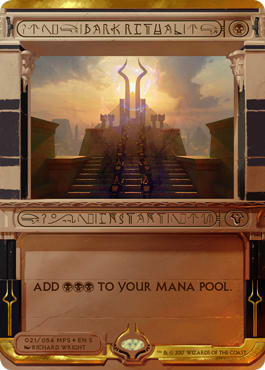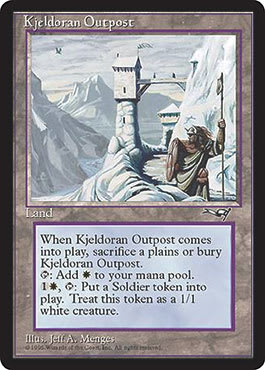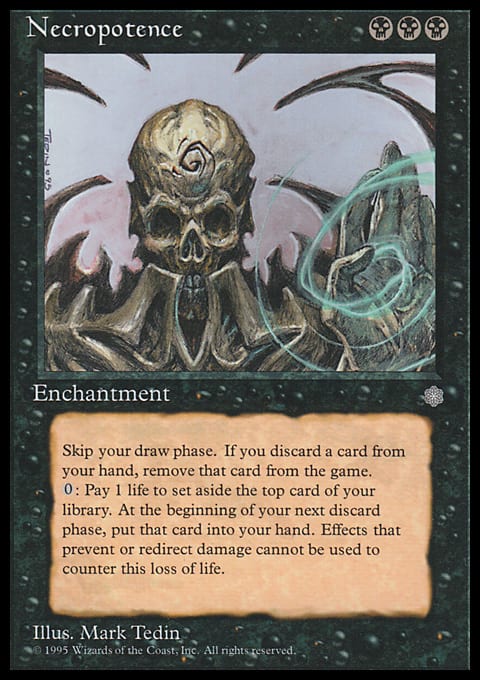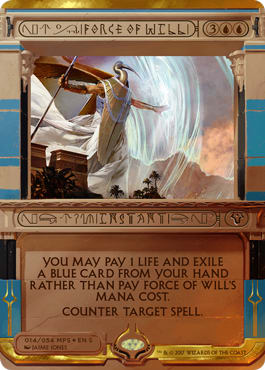I’m old.
Not in real-world terms. I’m “only” thirty, after all. My legs only hurt for like two days after soccer games. I can totally drink two beers without having a hangover. I only receive AARP mailings once every few months.
But in Magic terms, I’m kinda old. Every once in a while, I’ll have a conversation with a younger or newer player, and inevitably, I’ll be forced to admit that I’ve been playing Magic for longer than he or she has been alive. Heck, our current world champion was two years old when I opened my first Starter Deck (those were things back then, kids).
The thing is, I’m not alone. Someone inevitably chimes in that he or she started around the same time I did (Ice Age) or soon thereafter. And as the game ages, so do many of the old guard. And we keep on playing because we love it.
We’re pretty much the crowd Wizards seems to be aiming for with From the Vault: Twenty. Newer players just won’t get the same chills we do seeing Impulse, Wall of Blossoms, and Tangle Wire in a foil, collectable box. For them, it’s a new Cube card or Interesting Shiny Thing. For players who are like I am, it’s about where we were, what we were playing, and what that card meant. Not every card will strike the same chord, but for long-timers, many of them will carry some kind of story.
Here are some of mine.
Dark Ritual (1993)
I didn’t start playing until 1996, but that doesn’t mean I didn’t see the game in action before then. My earliest memory of the game was actually years before, around the time of Arabian Nights. I was on a soccer team with a kid named Austin whose entire family was into games. Later on, when I did start playing Magic, I would regularly be invited over to play Magic and Cosmic Encounters and to regularly ruin Call of Cthulhu sessions (the short version is that we never went on any adventures because I kept blowing up dimensional portals with dynamite).
My first interaction with the game was actually in a van on the way to or from a soccer game. Several of my friends on the team were playing on the floor (unsleeved!) while I mostly ignored them. But one memory, oddly enough, did stand out because one player shouted about how unfair it was and how he could never win. At the time, I just registered that there were two black cards involved. It was only later that I would figure out Dark Ritual had powered out a turn-one Juzam Djinn (thanks to a Mox I believe).
And though Juzam Djinn has long been outmoded (and virtually reprinted) many times over, Dark Ritual has never been replicated. And it will forever be linked to the first game of Magic I ever birded.
Swords to Plowshares (1994) and Impulse (1997)
When I first started playing Magic, there were very few places to play. Our “local” game store was located in a nearby mall, and it had zero play space. Our tournaments were actually held in the food court.
After a year or so of playing mostly on the floor of my game room or that of my friend Brian, I had started venturing out into tournaments. The food court tournaments were my first real forays into competitive Magic. But by that time, I had also discovered Magic magazines and the little information that existed on the Internet. Competitive as I was, I did a ton of research before heading out to play. That was how I found Browse-Post.
For those who don’t know and who don’t care to click the link, Browse-Post was an archetypical W/U control deck that had zero creatures and very few ways to win. It abused the interaction between Browse and Soldevi Digger to virtually stack its library over the course of the game. Gerrard's Wisdom let you recover from any amount of damage, Abeyance was Time Walk, and Thawing Glaciers was at its peak.
The deck also happened to rely heavily on four Impulses—then considered among the best cards in the game—and four Swords to Plowshares—long established as the game’s best removal. To this day, it was the best, most complete control deck I have ever played. It still have a soft spot for all of the cards, and I try to include Browse, Kjeldoran Outpost, Thawing Glaciers, and Impulse in Commander decks as often as possible.
As fun as that nostalgia is, that’s not the story here. One day, I was slinging some Swords and Impulses in the food court when my nightmare scenario happened: Someone saw me.
Not just any someone, but the cool kids on my soccer team. At the time, I was a sophomore in high school, but I had made the varsity soccer team. (Brag about athletic accomplishments in a Magic column: check.) And Magic, back then even more so than now, was a bit of a social stigma. So, I was terrified.
But something fantastic happened. They saw me, said “hi,” made a few jokes, asked a few questions, and then continued on their way. They mentioned it later, but they never made fun of me or made me feel bad. The social stigma, though very real for some, was mostly in my head when it came to my teammates and friends. People who knew me well not only didn’t care, but found it interesting and—in some cases—endearing.
Since then, I’ve never been shy about it. Even after Jon Finkel was publicly shamed about his status as a Magic god by an angry blogger, I’ve always let women know I play. It’s not exactly difficult for them to find out if they do so much as Google me or check out Facebook, but since that day I was caught Impulsing, I haven’t cared if I was “found out.”
Magic is part of who I am and who I have been for seventeen years. There’s no reason to hide from it just because it’s a bit geeky. We all learn that lesson eventually. Mine just happened across from a Chik-fil-A.
Hymn to Tourach (1995)
I have no stories about this card in particular, though I’ve cast it many a time. I do remember that this was, by far, the most frustrating card to play against—more so than Armageddon, more so than Stone Rain, and more so than Necropotence.
Why?
Because this card always hits your only land. Every. Single. Time.
Fyndhorn Elves (1996)
Despite my love of Impulse, despite my proclivity for control, no card in From the Vault: Twenty encompasses my early playing years better than Fyndhorn Elves. It checks off three levels of my early playing days that no card outside of Balduvian Horde can touch.
(Side note: Balduvian Horde was the Arcbound Ravager/Voice of Resurgence/special chase card of its day. I kept mine in a glass case with actual screws on it, as though it were a Honus Wagner baseball card. Only Jester's Cap came close. My, how things have changed.)
Level 1: Ice Age was the first set I started playing with, and my first Starter Box was the light-blue Ice Age Starter. I don’t remember if that particular box had any Fyndhorn Elves in it, but I know for sure that I soon had four copies, because . . .
Level 2: Back in the day, there was a magazine called Inquest that went back and forth between being laughably misleading to incredibly informative. For example, the “best card” in Alliances, according to Inquest, was the previously-mentioned Balduvian Horde. Force of Will was third. Kjeldoran Outpost and Thawing Glaciers weren’t mentioned. Dream Halls was the “worst card” in Stronghold.
At any rate, they also published decklists. It was where I found the Browse-Post list. It was also where I started to like blowing up lands.
I still distinctly remember the issue and the article. It listed the Top 4 archetypes in Standard at the time. Number one was Necropotence. Two was Ernhamgeddon (Armageddon with Erhnam Djinn). Four was Turbo Stasis. Three, however, was R/G land destruction, featuring Stone Rain, Pillage, the full four Strip Mines, my beloved Balduvian Horde, Stormbind, and the full eight Elves available at that time: Llanowar and Fyndhorn. It was quintessential Inquest, and it was an article that guided my Standard (then Type 2) decks for some time.
Level 3: That, not coincidentally, was when learned about the effects of fast mana and land destruction. That deck is still the one I mourn when I think about land destruction, and though some people hate it, I actually love playing those kinds of resource-denial decks. I’ve tried recreating them with Cryoclasm-style decks and the like, but never to the same effect. That R/G deck and Browse-Post were my first two introductions to higher-level decks, and they will forever color my approach to the game.
Wall of Blossoms (1998)
Everyone remembers the Recur-Sur deck Brian Selden used to win the 1998 World Championship, but my first introduction to Wall of Blossoms seems to be lost to the ravages of time.
Again, this memory comes from a decklist I saw in Inquest, but I just thought it was so cool at the time. It was, if memory serves, a five-colored green deck that used City of Brass and Gemstone Mine to splash cards such as Incinerate, Memory Lapse, Swords to Plowshares, Tradewind Rider, and more while holding the fort with green cards. I think there was a base-black version of the deck as well.
Though I remember the article vividly (it was a sidebar; the background was an orangish hue; it’s strange the things we remember), I don’t remember much else about it beyond that.
That, however, would come to be replaced by Donias (as in Joeff Donias) five-color blue. Now that was a control deck. With Impulse, Whispers of the Muse, Dismiss, Gerrard's Wisdom, and Gaea's Blessing all in the same deck, plus Fireball as a “finisher” (the real finisher was decking), it was the first control deck since Kjeldoran Outpost to capture my attention. I think what got me about these decks was that they just played the game fundamentally differently than other strategies. I never wanted to win the “normal” way (by attacking), and winning by repeatedly recycling Gaea's Blessing just tickled me the right way.
So, this past week when I played Trading Post with Elixir of Immortality and actually won a forty-five-minute Game 1 against Jund (but oddly enough finished a three-game set against U/B Drownyard Control), I felt a similar kind of rush slowly expanding my resources while denying them to my opponent. I even got the chills when Elixir shuffled in a spent library. The deck might have been W/U, but it felt positively G to be able to play Magic that way again.
The only thing missing, in my eyes, was a 0/4 Wall that cantripped.
Thran Dynamo/Tangle Wire/Fact or Fiction (1999, 2000, 2001)
Eventually, as with all young men of a certain age, my thoughts turned from Elves and walls made of flowers to girls—prom, in particular. And a girl named Kate.
Kate was beautiful (still is, twelve or so years later). Kate also had a boyfriend during the run up to prom. But it didn’t matter either way . . . my mind was pretty set on not going to prom anyway.
Back then (actually, still), I had a bit of an anti-peer-pressure streak in me. I thought that, if everyone was doing it, it must be awful. School dances were not only included in that adolescent logic train of brilliance, but were the foremost example. I even skipped one dance to go see Dude, Where’s My Car? on opening night. I maintain I made the right choice.
So, I was all set to not go to prom—all set until Kate suddenly became available.
We were already fairly good friends, at least as far as high school friends of the opposite sex who never see each other outside of school go. We shared a period together, as our classes often meshed and merged, allowing for time to hang out. Our social circles overlapped, but only slightly. Kate was blonde, gorgeous, fun, and suddenly available. So, I asked her to prom.
She said “no.” She wasn’t planning to go to prom at all.
Fast forward a week or so. I had been convinced to go stag to prom, but I didn’t care much to look for another date. I had been late to the party, so anyone I wanted to ask was already taken. Kate, as it turned out, found herself suddenly wanting to go and in the same situation.
So, the day before I was supposed to go out of town for a week for an academic competition, I received a note to come to a teacher’s classroom during my study hall. I showed up, and Kate was there. The teacher left and gave us the room. Kate, nervously and very sweetly, asked me to prom.
I said I wasn’t sure.
I was kidding. I mostly was making her sweat it out. I said “yes,” was ecstatic, and began making plans.
My Magic-playing was already waning somewhat. We had moved to a new state and a new high school, and I had already lost some momentum in the transition. I still played now and then, but not nearly as much as the days when I could be dropped off at the food court. Kate helped put the nail in the coffin when I realized I couldn’t quite pay for prom with the funds on hand.
So, I did what millions of kids that age did when money became an issue. I sold my Magic collection—including play sets of Force of Will, Wasteland, and the like—to pay for prom. My cousin had started playing, and his mom was more than happy to buy my collection from me.
So, what does all this have to do with Thran Dynamo, Tangle Wire and Fact or Fiction?
I never really played with them while they were in Standard. Because these were the years that I quit Magic . . .
Stay tuned for Part 2, coming next week.






























